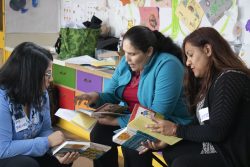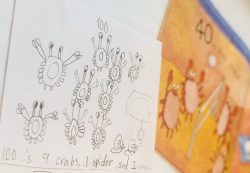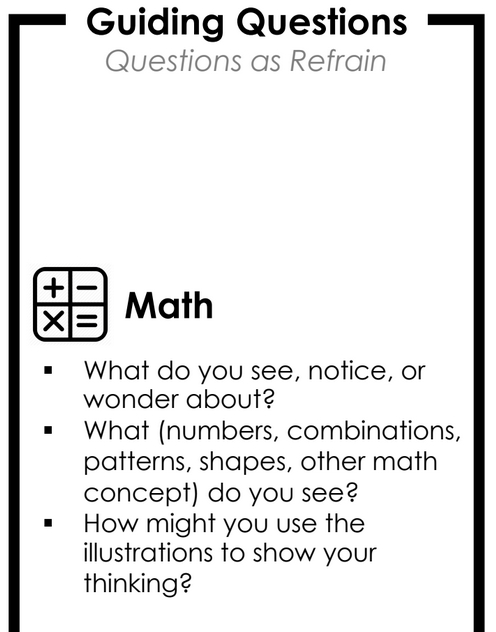Read-Alouds and Discussion
Read-Alouds and Discussion: An Overview

Reading aloud to children has many benefits, including motivation, engagement, creative response, and building content-area knowledge. Reading aloud provides opportunities to engage children in actively exploring the ideas and illustrations in a text and to support the development of listening comprehension, receptive and expressive language skills, syntactic development, and vocabulary and concept knowledge . Read-aloud discussions support children in learning to read and think more deeply about ideas in text . Strategic use of discussion focused on mathematics provides opportunities for students to communicate ideas as they engage in sense-making discourse, supporting the development of understanding concepts behind operations and nurturing positive mathematical identities . Modeling discussion strategies is particularly helpful for increasing children’s academic achievement and enhancing opportunities for them to become successful readers.
Types of Read Alouds
In the Story Time STEM project we have developed three different types of read-alouds to explore children’s literature and to foster engaging discussions of story and mathematical ideas. The read-alouds described in the Story Time STEM modules fall into three different categories: Open Notice and Wonder, Math Lens, and Story Explore
Open Notice and Wonder
What do you notice? What do you wonder? There is great promise in beginning the exploration of a book by inviting children to share what they notice and wonder! An Open Notice and Wonder read-aloud allows us to enjoy the story. We can marvel; understand the characters, setting, plot, and illustrations; laugh, experience emotions, and fully get inside a story. It’s also a time to listen for what children notice and wonder about mathematically, unprompted. Give these questions a try and stick to only asking, What do you notice? What do you wonder? Listen carefully to children’s ideas with curiosity and joy!
Math Lens
Sometimes it is exciting to focus your read-aloud experience on the mathematics in a story. We call this a Math Lens read-aloud. A Math Lens read-aloud could come after an Open Notice and Wonder – as a subsequent of the same story – where you further investigate the mathematical noticings and wonders children shared. OR a Math Lens read-aloud can be the first read of a story where you invite children to put on their math lenses. This might sound like, “Today, mathematicians, let’s explore this book with our math lenses on. Join me, as we explore this story as mathematicians!” Our goal is to think about the story as mathematicians and find joy and beauty for math in everywhere in our world.
Story Explore

Sometimes it is exciting to focus your read-aloud experience on the literary elements in a story. We call this a Story Explore read-aloud. A Story Explore read-aloud could come after an Open Notice and Wonder – as a second read of the same story – where you further investigate the literary noticings and wonders children shared about setting, plot, character traits and actions, or vocabulary. OR a Story Explore read-aloud can be the first read of a story where you invite children to put on their reading lenses. This is particularly true for stories with a surprising turn of events or plot twist, where the first read-aloud is the moment when the surprise is experienced and when stopping here and there to predict story events is particularly exciting! This might sound like, “Today, readers, let’s explore this story with our reading lenses on. Join me, let’s put on our reading lenses and explore as readers, stopping now and then to ask ourselves, ‘What do we think will happen next, and why do we think this?’” Our goal is to think about the story as readers and find joy and beauty for narrative and language in our world.
Across our years of research and working with teachers and librarians on mathematizing children’s literature, we have learned that there are certain book characteristics holding widespread appeal for reader and listener alike. These include:
- Hook – What instantly attracts children’s attention?
- Humor – Is there a silly premise, funny plot, or hilarious words or characters to encourage laughter?
- Emphasis – Are there characters, actions, feelings or elements of the plot that can be emphasized when reading aloud?
- Narrative pacing – Do parts of the story happen very quickly or do they unfold more slowly and deliberately?
- Literary style – What is the mood, atmosphere or tone of the text?
- Visual interest – What is the artistic quality of illustrations in the text, and how might illustrations help enhance the story experience?
- Audience participation – Is there a repeated phrase or action to encourage children to join in reading the story?
- Engaging Experience – What do children feel in hearing and seeing the story and how do they choose to engage with it?
Questions as Refrain: A tool to help you engage during read alouds

Having a few open-ended questions we can rely on to ask at any time, in any read-aloud, is helpful, so we’ve provided a handy bookmark for you to print and use during your read aloud sessions.
As teachers we often ask children, “Can you tell me more about your thinking?” or “How do you know that?” In addition to “What do you notice?” and “What do you wonder?” We have a short list of questions like these that we carry with us during any read-aloud experience; we call these Questions as Refrain, and we find they work well with almost any story to hear children’s thinking and nurture their exploration of ideas.
Questions such as “How might you use the illustrations to show your idea?” or “What will happen next? How do you know?” allow us to hear more about, and more deeply understand, children’s thinking. We have found that these open-ended “questions as refrain” help students explore multiple story dimensions as readers and mathematicians, and these questions we ask over and over again become a part of who we are as a learning community. Download the printable bookmark for use in your own read-alouds. We invite you to expand on these questions, making them your own in your community.
